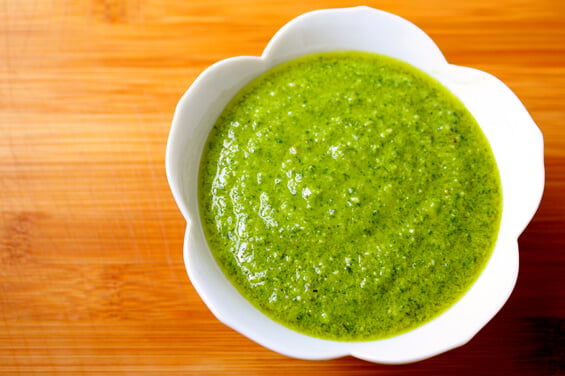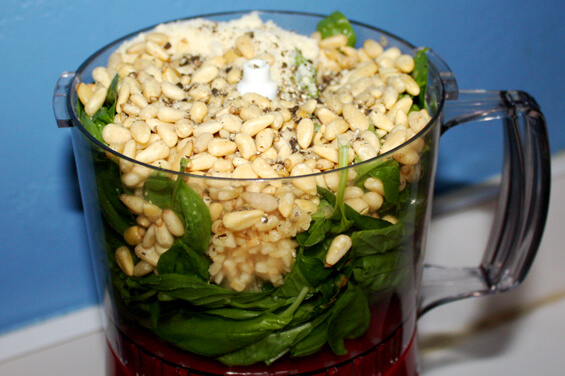
I realized the other day that it’s been awhile since I’ve made a basic, classic pesto. Most of the time I love experimenting with random ingredients, and enjoy seeing what creative deliciousness can result. But with a (still!) overflowing basil plant, and a jar of pine nuts in the pantry, I decided this week that it was time to revisit a classic. :)
That said, making pesto is undoubtedly more about the method than the recipe. So I thought this would be a fun post to offer the basics for proportions for pesto ingredients. And then you can either make the classic recipe, or do some of your own mixing and matching and creative experimenting. The joy of pesto is that it’s very hard to go wrong here. Most ingredients blend pretty well together. And if by chance you do end up adding a little too much of this or that, you can always just add more of the other ingredients and overpower whatever was too strong.
And while pesto is traditionally regarded as a “summer” recipe, I’ve included some year-round ingredient substitution ideas below as well. Enjoy!!

Classic Basil Pesto Recipe(Original recipe)
Ingredients:
In a food processor or blender, blend together basil, nuts, garlic, and cheese. Pour in oil slowly while still mixing, and then add in salt and pepper. Scrape down the sides and pulse once more to make sure it’s well-blended.
Possible ingredient substitutions:*Note that you may need slightly more or less, as some of these are stronger than others
Ingredients:
- 1/2 cup pine nuts
- 3-4 cloves garlic (I think the more, the merrier!)
- 3 cups fresh basil leaves, packed
- 1/2 cup freshly grated Parmesan
- 1/2 cup extra-virgin olive oil
- salt and freshly ground black pepper to taste (or about 1/2 tsp. of each)
In a food processor or blender, blend together basil, nuts, garlic, and cheese. Pour in oil slowly while still mixing, and then add in salt and pepper. Scrape down the sides and pulse once more to make sure it’s well-blended.
Possible ingredient substitutions:*Note that you may need slightly more or less, as some of these are stronger than others
- For basil: herbs (parsley, cilantro, sage, mint, tarragon, dill, etc.), greens (spinach, arugula, etc.), veggies (asparagus, artichokes, sun-dried tomatoes, etc.)
- For pine nuts: walnuts, pecans, pistachios, etc.
- For parmesan: romano, asiago, etc.
- Other add-ins: spices (cayenne, chile powder, ginger, nutmeg, paprika, special salts/peppers, etc.), fresh ginger, etc.
- Pastas: Simply stir in the sauce after cooking pasta. Mix with veggies or meats/poultry/seafood.
- Potatoes or gnocchi: For mashed potatoes or gnocchi, stir in after potatoes are cooked. Use to top baked potatoes after they are cooked.
- Spread: Use as a spread on toasted slices of baguettes. Or spread atop slices of french bread, and pop under the broiler until they are golden and bubbly.
- Soups: Add a dallop to your favorite soup just before serving.
- Dips: Use as a dip for fresh veggies, chips, or breads.
- Drizzle: Add extra oil to thin out sauce, and drizzle atop grilled meat, veggies, or salads. Or use as a marinade.
- Pistou: Leave out the nuts, and make this classic thinner French sauce.
- Sauce it up: Use as you would any other sauce to add flavor (e.g. to top meats/poultry/seafood, to mix into meatloaf, salads, etc.)
- Refrigerate: Store in a jar and tightly seal. To extend its life and prevent, pour a small layer of olive oil on top to keep the air out of the pesto. Keep for one week. (Although many contend it safely last longer, I would freeze the pesto if you want to use it after a week.)
- Freeze: I love-love-love freezing pesto in ice cube trays. This way you can control your portions, and just thaw out exactly as much as you need. To freeze, just grease an ice cube tray with cooking spray (or line it with plastic wrap), and then pour in the pesto and freeze.

Ali’s Tip:
I just recently learned the key to learning how to reap the most from your basil plants each summer. It’s all about making sure you keep it cut down (and thus – have more to use!). Here’s a link to a great tutorial I found on the web. http://gimmesomeoven.com/how-to-make-pesto/
No comments:
Post a Comment